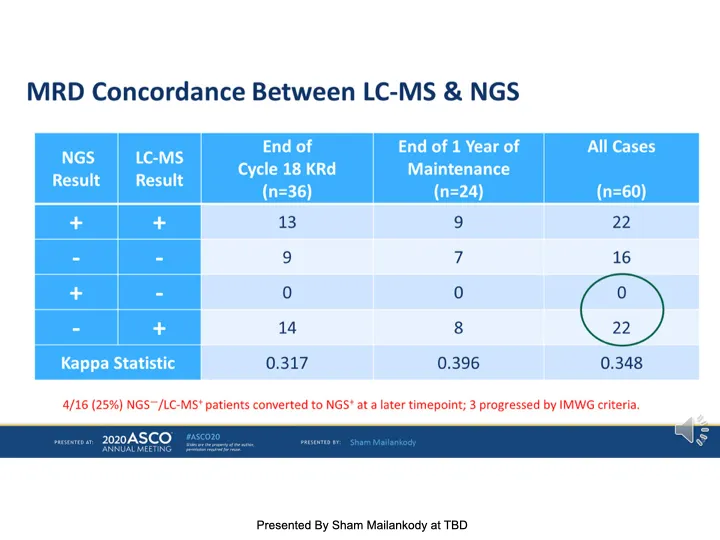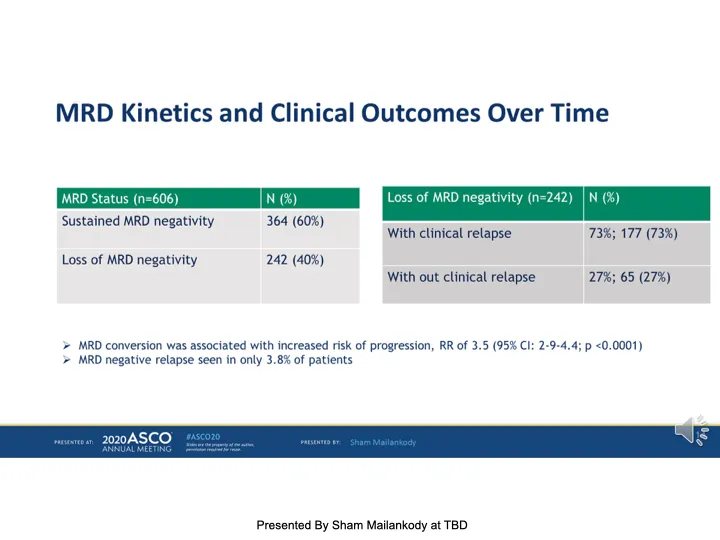ASCO 2020: Mass Spectrometry in MRD Assessment

Minimal Residual Disease (MRD) testing is used to determine the level of disease following myeloma therapy. It is a more sensitive way of testing very low levels of myeloma that go beyond today's blood and bone marrow biopsy tests. (Learn more about MRD here). In a recent ASCO session, Sham Mailankody, MBSS from Memorial Sloan Kettering Cancer Center, shared three studies comparing mass spectrometry to flow cytometery and next generation sequencing for MRD testing and examined the implications of loss of MRD negativity.
Current myeloma therapies are providing deep responses. This has led to the development of tests detecting minimal residual disease. MRD assessment has been done primarily with bone marrow testing using flow cytometry or next generation sequencing. Both rely on serum immunofixation. Biopsies are also invasive, painful (ouch!) and can have limitations in measuring patchy as well as extramedullary disease which could result in a false negative.
More recently, a new test has been developed that determines the molecular mass of specific molecules in a sample, called Mass Spectometry. This blood-based test has the potential to be more sensitive than bone marrow-based tests.
The GEM-CESAR study from Spain with Dr. Puig compared MRD assessment with Flow Cytometry
Key Findings:
- Mass Spectometry based assessment is significantly more sensitive than conventional immunofixation. At the end of consolidation, 66% of patients had detectable myeloma with mass spectrometry compared to 24 % of patients by immunofixation
- MRD negativity with flow cytometry improved over time with consolidation with over 40% achieving MRD negative status
- When compared to bone marrow based flow cytometery, peripheral blood based mass spectrometry had a sensitivity of approximately 90-91%
- Follow up at 35 months: Progression Free Survival was 92% and Overall Survival was 96%
Mass Spec Vs. Next Generation Sequencing
The second study was a phase two trial by Dr. Benjamin Derman at the University of Chicago included sixty patients with newly diagnosed multiple myeloma and compared mass spectrometry with next generation sequencing. Study participants received Kyprolis/Revlimid/Dexamethasone for four cycles followed by autologous stem cell transplant, an additional fourteen cycles of KRD and one year of Lenalidomide maintenance. MRD testing was completed upon initiation and completion of maintenance treatment with the following results:

Key Findings:
- MRD negativity with both mass spectometry and NGS was associated with improved progression free survival (PFS)
- Twenty three individuals were NGS negative and only 9 were mass spectometry negative
- Progression free survival for the fourteen individuals that were mass spectometry positive was lower than those who were mass spectometry negative
Follow up was completed at 56 months with the following take away results:
- MRD assessment with mass spectometry may exceed sensitivity of NGS by at depth of 10 -5 to 10 -6
- in some cases mass spectometry positivity predicted conversion of patients converting from NGS - to NGS+
- Mass spectometry negativity was associated with improved progression free survival in entire cohort
Clinical Implications of Losing MRD Negativity
The third study was led by Dr. Mohan University of Arkansas. His team examined the clinical implications of loss of MRD negativity. This was a retrospective cohort study of 606 newly diagnosed myeloma patients with MRD assessments completed between 2014 and 2019 with the following findings:
- 60% of patients had sustained MRD negativity at follow up
- 73% of patients who became MRD negative had clinical relapse and 27% did not
- MRD conversion was associated with significantly increased risk of progression
- Event free and overall survival was significantly better for those with sustained MRD negativity.
What can we learn from all of this?
- Blood based mass spectrometry assessment has promising sensitivity
- Mass spectrometry could replace conventional bone marrow based MRD assessments
- Sustained MRD negatviity has significant impact on prognosis and is associated with excellent event free survival as well as overall survival.
Minimal Residual Disease (MRD) testing is used to determine the level of disease following myeloma therapy. It is a more sensitive way of testing very low levels of myeloma that go beyond today's blood and bone marrow biopsy tests. (Learn more about MRD here). In a recent ASCO session, Sham Mailankody, MBSS from Memorial Sloan Kettering Cancer Center, shared three studies comparing mass spectrometry to flow cytometery and next generation sequencing for MRD testing and examined the implications of loss of MRD negativity.
Current myeloma therapies are providing deep responses. This has led to the development of tests detecting minimal residual disease. MRD assessment has been done primarily with bone marrow testing using flow cytometry or next generation sequencing. Both rely on serum immunofixation. Biopsies are also invasive, painful (ouch!) and can have limitations in measuring patchy as well as extramedullary disease which could result in a false negative.
More recently, a new test has been developed that determines the molecular mass of specific molecules in a sample, called Mass Spectometry. This blood-based test has the potential to be more sensitive than bone marrow-based tests.
The GEM-CESAR study from Spain with Dr. Puig compared MRD assessment with Flow Cytometry
Key Findings:
- Mass Spectometry based assessment is significantly more sensitive than conventional immunofixation. At the end of consolidation, 66% of patients had detectable myeloma with mass spectrometry compared to 24 % of patients by immunofixation
- MRD negativity with flow cytometry improved over time with consolidation with over 40% achieving MRD negative status
- When compared to bone marrow based flow cytometery, peripheral blood based mass spectrometry had a sensitivity of approximately 90-91%
- Follow up at 35 months: Progression Free Survival was 92% and Overall Survival was 96%
Mass Spec Vs. Next Generation Sequencing
The second study was a phase two trial by Dr. Benjamin Derman at the University of Chicago included sixty patients with newly diagnosed multiple myeloma and compared mass spectrometry with next generation sequencing. Study participants received Kyprolis/Revlimid/Dexamethasone for four cycles followed by autologous stem cell transplant, an additional fourteen cycles of KRD and one year of Lenalidomide maintenance. MRD testing was completed upon initiation and completion of maintenance treatment with the following results:

Key Findings:
- MRD negativity with both mass spectometry and NGS was associated with improved progression free survival (PFS)
- Twenty three individuals were NGS negative and only 9 were mass spectometry negative
- Progression free survival for the fourteen individuals that were mass spectometry positive was lower than those who were mass spectometry negative
Follow up was completed at 56 months with the following take away results:
- MRD assessment with mass spectometry may exceed sensitivity of NGS by at depth of 10 -5 to 10 -6
- in some cases mass spectometry positivity predicted conversion of patients converting from NGS - to NGS+
- Mass spectometry negativity was associated with improved progression free survival in entire cohort
Clinical Implications of Losing MRD Negativity
The third study was led by Dr. Mohan University of Arkansas. His team examined the clinical implications of loss of MRD negativity. This was a retrospective cohort study of 606 newly diagnosed myeloma patients with MRD assessments completed between 2014 and 2019 with the following findings:
- 60% of patients had sustained MRD negativity at follow up
- 73% of patients who became MRD negative had clinical relapse and 27% did not
- MRD conversion was associated with significantly increased risk of progression
- Event free and overall survival was significantly better for those with sustained MRD negativity.
What can we learn from all of this?
- Blood based mass spectrometry assessment has promising sensitivity
- Mass spectrometry could replace conventional bone marrow based MRD assessments
- Sustained MRD negatviity has significant impact on prognosis and is associated with excellent event free survival as well as overall survival.

about the author
Rozalynn Hite
Rozalynn Hite is the HealthTree Coach Director and wife of myeloma patient Richard Hite. Rozalynn is an occupational therapist and mother of three beautiful children. She is passionate about providing support, education, and resources to help others live full and active lives.
More on Treatment Advances
Trending Articles




Get the Latest Multiple Myeloma Updates, Delivered to You.
By subscribing to the HealthTree newsletter, you'll receive the latest research, treatment updates, and expert insights to help you navigate your health.















